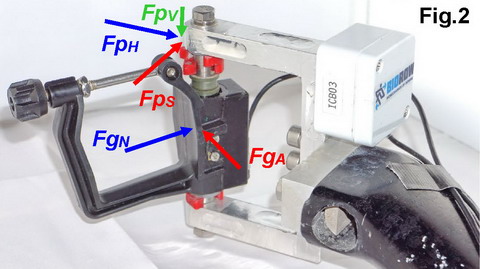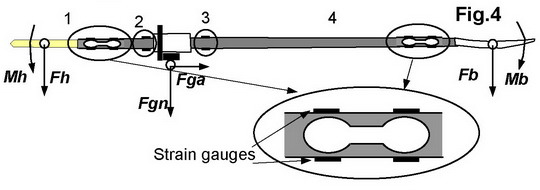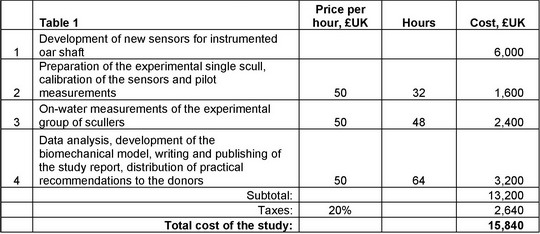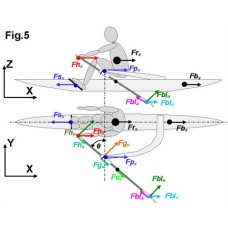 BioRow Research & Development project
BioRow Research & Development project
Power production and transfer in rowing
©2020 Dr. Valery Kleshnev
Introduction
Power production, transfer and its conversion into the kinetic energy of the rower-boat system is a very important, yet still uncertain area of Rowing Biomechanics. While working on this topic for more than two decades (the first significant article was published in 1996, see 1 in References below), numerous studies on the matter have been completed. Here is a brief list of previous developments and findings:
1995-2002 (1-4) A basic methodology has been developed. Three methods of power calculation have been identified: 1) Traditional handle power, 2) Propulsive-waste power, 3) Rower’s body segments power.
2000-2003 (5-6) Methods of determining blade propulsive efficiency were developed. Special sensors measuring the force and torque at the blade were developed, which allowed the determination of the centre of pressure at the blade.
2004-2010 (7) A theory of micro-phases during the stroke cycle was developed, which was based on the accelerations of the rower’s, boat’s and whole system’s masses. The theory connected various biomechanical variables and laid a background for the model of power conversion into kinetic energy.
2010-2012 (8) The phenomenon of power transfer through the stretcher-boat hull from one rower to another was discovered, which affects measurements using the traditional handle power method.
2012-2014 (9-10) A new instrumented gate sensor was developed and used in a study of the ratio of the handle-gate-blade forces. The discovered phenomenon of varying ratios during the drive still cannot be explain with the existing biomechanical models.
2014-2020 (11-15) Sensors measuring multidimensional forces at the pin and stretcher were designed. Pilot measurements have demonstrated the high accuracy and reliability of the sensors, and the results were used in the advanced model of power production, transfer and its conversion into kinetic energy.
Currently, the following phenomena remain unclear and are awaiting further studies:
- The centre of pressure at the blade is not defined and experimentally verified, which affects the actual outboard length, ratio of the handle-gate-blade forces and accuracy of the force-power measurements.
- P.1 above does not allow for the accurate definition and verification of the total propulsive force acting on the rower-boat system, shares of propulsive and waste powers and efficiencies of the blade work and a specific rowing technique.
- A complete model of a rower’s power transfer through the oar-blade, stretcher-boat-rigger and its conversion into kinetic energy remains unknown, due to the very complex nature of external and internal components of the power exchange.
Purpose and tasks
The main purpose of the study is to fill the above gaps in our knowledge in Rowing Biomechanics, to develop and experimentally verify a complete model of power production, transfer, its conversion into kinetic energy and dissipation in the drag resistance.
The following tasks must be completed:
- A new sensor should be developed, which reliably measures the blade force, independent of the centre point of its application.
- Together with existing methods of oar torque measurements, the aforementioned sensor would allow for the definition of the position of the centre of pressure at the blade, total propulsive force and its ratio to the measured handle and gate forces.
- Reliable information about the propulsive force would allow one to calculate the propulsive power, compare it with the gain in kinetic energy of the rower-boat system and verify the biomechanical model of rowing power production and transformation.
- Pilot studies of a few samples of different rowing technique and equipment (various rigging settings, blade shape, etc.) would allow for the finding of optimal trends and thus improvement of rowing performance.
Methods
Data collection, existing equipment
The following biomechanical variables will be measured with the standard BioRow telemetry system (Fig.1): the handle force (torque on the inboard), oar angles in horizontal and vertical planes (RBN 2009/10), seat and trunk movements (2014/12), boat speed, 3D acceleration and 3D rotations (2012/03), wind speed and direction (2013/06).

The recently developed BioRow instrumented gate and C-bracket (Fig.2) will be used for measurements of the gate and pin forces. Forces at the gate will be measured at the normal to the oar axis FgN and axial direction FgA. The instrumented C-bracket will measure 3D force at the pin: in horizontal FpH, side FpS and vertical FpV directions.

The stretcher force will be determined at three points with the BioRow v.2009 sensors (RBN 2013/08), which measure the horizontal force components FsH only (Fig.3).

Equipment to be developed
Instrumented oar shafts will be developed: each shaft will have four full strain-gauge bridges, which will be glued on to specially designed load cells or directly onto the shaft. A total of four channels of force and torques will be measured at each oar-gate:
< >Handle force Fh (Fig.4) will be measured using an instrumented oar handle with a binocular-shape cut and glued strain-gauges. This design makes the force reading independent at the point of the force application at the handle.Torque of the handle force Mh will be measured using strain-gauges glued on the inboard of the oar shaft close to the sleeve and button.Torque of the blade force Mb will be measured using strain-gauges glued on the outboard of the oar shaft close to the sleeve.Blade force Fb will be measured using a binocular-shaped cut with glued strain-gauges close to the blade. This design makes the force reading independent at the point of the force application at the blade.

Test protocol
One experimental dedicated single scull will be equipped with the above sensors and telemetry system. Each participant of the study (from two to six scullers) will perform sets of test trials in the instrumented single scull: approximately 250m each trial with 1-2 min. recovery time, and with incrementally increasing stroke rate in each trial (from 18-20 up to 40-44 spm). The sets of trials could be repeated several times after amendments to the rigging settings.
Data analysis and modelling
The data will be collected with a data logger on the BioRowTel system, downloaded onto a PC and then processed using special software. The data from all stroke cycles of each trial will be normalised and averaged to obtain typical patterns over the stroke cycle for each primary variable. Then patterns of derived variables will be calculated (e.g.: power variable will be derived from the force and velocity variables, etc.). Both primary and derived variables will be used for the calculation of single value or discrete variables (e.g.: stroke length, maximal and average force, power, etc.).
All possible cross-validation of the data will be performed: e.g., forces measured at the gate, pin and the handle will be cross-validated using oar and gate angles, resultant propulsive forces will be validated with known masses and measured accelerations, etc. This should provide reliable data analysis and outcomes of the study.
A three-dimensional biomechanical model of the rower-boat system will be used (Fig.5) with two reference frames: 1) a global frame based on the water mass will be used for propulsive and total power calculations and its transformation into kinetic energy; 2) a local (centre of momentum) frame will be used for the calculation of internal power exchange within the rower-boat system.

The proposed study is going to be the most detailed and comprehensive study ever undertaken in the history of Rowing Biomechanics. A unique set of information will be collected, which contains the total number of 36 measured data channels from one single scull.
Expected outcomes
The obtained data will allow for the calculation of the centre of pressure at the blade, actual outboard length, and the ratio of the handle-gate-blade forces, then cross-validate them to ensure the accuracy of the measurements.
From this, the total propulsive force acting on the rower-boat system will be derived, as well as the propulsive/waste powers and efficiencies of the blade work and specific rowing techniques.
Finally, a complete model of rower’s power transfer through the oar-blade, stretcher-boat-rigger and its conversion into kinetic energy will be developed and validated with the measurements data.
Practical implications
The developed biomechanical model will be used for optimisation of various parameters of rowing technique, such as stroke length and oar angles, dynamics of force application (force curve), boat acceleration and velocity patterns, blade work and sequence of body segments activation during the drive and recovery phases. Also, several boat and oar rigging settings (inboard, oar length, span/spread, etc.) could be optimised with the developed biomechanical model.
Optimisation of biomechanical variables of rowing technique and oar-boat rigging should decrease the counter-productive energy losses in a rowing stroke, increase rowing efficiency, and maximise rowing speed and performance.
Cost of the study
The Table 1 shows breakdown of expenses required to complete the study:

Acknowledgements
Each significant donor will be acknowledged in publications related to this study and will receive a full report with recommendations on rowing technique improvement, as well as a special gift from BioRow and a selection of the best BioRow publications.
Only donors will receive the practical outcomes of the study, which would allow them to optimise their rowing technique, equipment settings and achieve an advantage over their competitors.
Finally, the donors will have the opportunity to ask questions related to the study and receive personal recommendations on improvement of their rowing performance.
References
- Kleshnev V. 1996 The effect of stroke rate on biomechanical parameters and efficiency of rowing. XIV Symposium ISBS, Proceedings, Lisboa, Portugal p. 321-325.
- Kleshnev, V. 1997. The determination of total power during on-water rowing. XVI Congress of ISB, Tokio, Book of Abstracts.
- Kleshnev, V. 1999. Propulsive efficiency of rowing. XVII Symposium ISBS, Proceedings, Perth, Australia p. 224-228.
- Kleshnev V. 2002. Power in Rowing. In: International Research in Sports Biomechanics. Ed. Hong Y. Routledge. P.224-230.
- Kleshnev V. 2003. Points of force application to the oar and efficiency of various blade designs. Report on research project. http://www.biorow.com/Papers_files/2003%20Blade%20Analysis.pdf
- Kleshnev V. 2004. Rowing Biomechanics Newsletter 2004/06. http://www.biorow.com/RBN_en_2004_files/2004RowBiomNews06.pdf
- Kleshnev V. 2010. Boat acceleration, temporal structure of the stroke cycle, and effectiveness in rowing. Journal of Sports Engineering and Technology, 233, 63-73.
- Kleshnev V. 2012. Power transfer through the boat. Rowing Biomechanics Newsletter 2012/04. http://www.biorow.com/RBN_en_2012_files/2012RowBiomNews04.pdf
- Kleshnev V. 2014. Ratio of the blade and handle forces. RBN 2014/02. http://www.biorow.com/RBN_en_2014_files/2014RowBiomNews02.pdf
- Kleshnev V. 2016. The Biomechanics of Rowing. Crowood Press. 190 p. ISBN 978 1 78500 133 8.
- Kleshnev V. 2018. Power And Kinetic Energy In Rowing. RBN 2018/11. http://biorow.com/index.php?route=information/news/news&news_id=40
- Kleshnev V. 2018. Discussion on Power in Rowing. http://biorow.com/index.php?route=information/news/news&news_id=39
- Kleshnev V. 2019. Balance of forces on the boat hull. RBN 2019/01. http://biorow.com/index.php?route=information/news/news&news_id=42
- Kleshnev V. 2019. Balance of Propulsive Forces. RBN 2019/02. http://biorow.com/index.php?route=information/news/news&news_id=43
- Kleshnev V. 2020. Rowing power and kinetic energy. RBN 2020/06. http://biorow.com/index.php?route=information/news/news&news_id=60
You can donate for this R&D project with PayPal below, or send us your request for invoice to valery@biorow.com
BioRow_research
- Product Code: BioRow research project
- Availability: In Stock
-
ÂŁ0.00UK
- Ex Tax: ÂŁ0.00UK
Tags: BioRow_research




